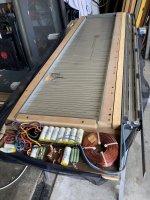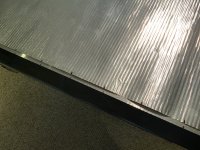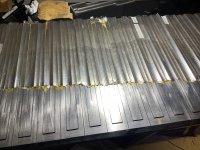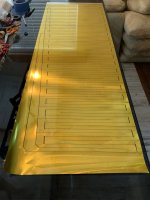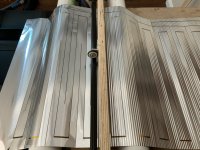Apparently unable to resist temptation, a set of apogee Duetta signatures came up near me so here we go again with making some
bass panels once again.. .
Cutting these out and rolling flat , widths and spacing are all over the place. There is no clear consistent width to each section so the approach
will be different
bass panels once again.. .
Cutting these out and rolling flat , widths and spacing are all over the place. There is no clear consistent width to each section so the approach
will be different
Attachments
Congratulations on the project! I have to ask why you wouldn’t just buy bass panels from Florian/Clarisys (no affiliation)?
https://clarisysaudio.ch/Apogee-Duetta-Parts-p207662869
https://clarisysaudio.ch/Apogee-Duetta-Parts-p207662869
I would imagine because this is "diyAudio", a forum for people to do things themselves. If you have the skills to do work yourself and save on cost, that would be the ethos behind all projects here.
I’m all for DIY. I’ve certainly done of lot of it myself for 45 years. But we all draw a line between buying parts and making them. Most of us doing an amplifier project wouldn’t dream of making our own transistors or tubes or even resistors. Probably not even transformers. My hat is off to anyone who goes in deeper.
The fabrication of the Apogee bass panels always seemed pretty daunting to me. I’m glad we have Clarisys and Graz who have made the R&D and production equipment investments to enable them to fabricate high quality bass panels for us. Even with panels and ribbons available, an Apogee rebuild is still a pretty adventurous project. But more power to anyone who seeks to fabricate his own panels.
I’m just curious what AVWERK’s thinking was here.
The fabrication of the Apogee bass panels always seemed pretty daunting to me. I’m glad we have Clarisys and Graz who have made the R&D and production equipment investments to enable them to fabricate high quality bass panels for us. Even with panels and ribbons available, an Apogee rebuild is still a pretty adventurous project. But more power to anyone who seeks to fabricate his own panels.
I’m just curious what AVWERK’s thinking was here.
He's a skilled craftsman I can personally vouch for. The scintillas he worked on belonged to me at one point where he brought them back from the grave. He's not building transistors or surface mount components, no, he's building foil membranes for his own speakers because like many of us, he's a glutton for punishment. lol. What is daunting for one man is child's play for another. Personally - I build IT infrastructures in my sleep but for many, that seems like an impossible task. Alas - here we are.
I think you mean "Rich Murry". I had a few speakers restored by him. I've moved onto other interests but glad to hear you're having fun with it all still!
They do make excellent panels and a big thumbs up on offering diyers the option but find it a little boring with no learning
curve. Nothing beats a good challenge…
I have no illusions of making as good as their offerings, but at the end of the day it’s still a strip of foil in a magnetic gap
What I didn’t do on making the divas and scintilla panels that will be done here , is pre run a sheet thru the “machine” stretch out to a final lay pattern,
lay it against the magnet rows, mark the magnet centers on the strectched foil, then flatten the foil out again to mark the cut sheet
more out of curiosity more accuracy and a different approach then before.
curve. Nothing beats a good challenge…
I have no illusions of making as good as their offerings, but at the end of the day it’s still a strip of foil in a magnetic gap
What I didn’t do on making the divas and scintilla panels that will be done here , is pre run a sheet thru the “machine” stretch out to a final lay pattern,
lay it against the magnet rows, mark the magnet centers on the strectched foil, then flatten the foil out again to mark the cut sheet
more out of curiosity more accuracy and a different approach then before.
Attachments
Sounds like you have had some experience with making panels before. Do keep us posted. Ever thought of making YouTube videos? 😀What I didn’t do on making the divas and scintilla panels that will be done here , is pre run a sheet thru the “machine” stretch out to a final lay pattern,
lay it against the magnet rows, mark the magnet centers on the strectched foil, then flatten the foil out again to mark the cut sheet
more out of curiosity more accuracy and a different approach then before.
Are you planning on driving on the ribbons directly?I’ll enjoy following his progress on this project, for sure.
I’m busy building my own-designed power amps for my Apogee Full Ranges, but I am happy to have had Aussie ribbons installed for me by Rich Murray!
Active on these no but the Scintilla have plans to do that down the road.
No YouTube videos sorry Brian.
Member Wrinex is the man and all he needs is a broken set of apogees 🙂 and that ball will start rolling
No YouTube videos sorry Brian.
Member Wrinex is the man and all he needs is a broken set of apogees 🙂 and that ball will start rolling
Yes. The woofer and tweeter will be driven by beefy voltage-source amps, while the 0.19 ohm midrange will be driven by a transimpedance amplifier.Are you planning on driving on the ribbons directly?
Excellent. I have commissioned Colin Wonfor to design an amp that will directly drive the MR of a Scintilla. It is going to have mind boggling current delivery capability.Yes. The woofer and tweeter will be driven by beefy voltage-source amps, while the 0.19 ohm midrange will be driven by a transimpedance amplifier.
One side done and ran out of foil for the other side so more is coming.
looks like I will have to move some magnets around to accommodate as an experiment on trying to match existing magnet dims didn’t work out as planned. The original sheet had wildly different foil widths for some reason. (1989 mfg.)
Maybe they were trying to suppress or distribute resonance ? Not sure their thinking here
The scintilla and diva foil widths for each run we’re consistant unlike these
made a jig to twist off each magnet and will use gorilla glue - just more work
looks like I will have to move some magnets around to accommodate as an experiment on trying to match existing magnet dims didn’t work out as planned. The original sheet had wildly different foil widths for some reason. (1989 mfg.)
Maybe they were trying to suppress or distribute resonance ? Not sure their thinking here
The scintilla and diva foil widths for each run we’re consistant unlike these
made a jig to twist off each magnet and will use gorilla glue - just more work
Attachments
Any chance of getting measurements from the duetta flat bass foil, it's hard to estimate the cuts needed from a old broken corrugated foil, from a flat foil it would be much easier...
I had read somewhere Apogee purposely made the panel asymmetrical to reduce bass output to shift the balance
towards the mid/highs. The signature definitely sounds more finely etched and detailed without the prominent bass
output.
Even though all the magnets are the same size as well as symmetrical spacing , post 369 shows where I measured each original foil width and indeed they are Asymmetrical widths so you have slightly different field strengths
acting on the panel
I would just go off the magnet spacing and forget trying to mimic their spacing because it’s hard enough in itself just to get
a perfect stretched layout over existing magnets let alone trying to alter each trace width along the way
towards the mid/highs. The signature definitely sounds more finely etched and detailed without the prominent bass
output.
Even though all the magnets are the same size as well as symmetrical spacing , post 369 shows where I measured each original foil width and indeed they are Asymmetrical widths so you have slightly different field strengths
acting on the panel
I would just go off the magnet spacing and forget trying to mimic their spacing because it’s hard enough in itself just to get
a perfect stretched layout over existing magnets let alone trying to alter each trace width along the way
Last edited:
Glad to see there is still support for the beloved Apogee. Quite few years back my pair of Scintilla’s were damaged extensively during a house move and at the time repair options were severely limited and cost prohibitive. Fast forward to today. I am about to become the proud owner of another pair soon. Also good to see some of the old participants from the Apogee forum. I went by the username ribbonrail and gleamed quite a bit of knowledge at the time about the Scintilla. Thanks to all that are contributing to keeping the illusion alive.
@Carlton8000: Am I right in assuming that the old Scintillas were damaged beyond economic repair? If you still have them I would be interested in buying the magnet arrays.
- Home
- Loudspeakers
- Planars & Exotics
- Anyone making Apogee bass panels?
